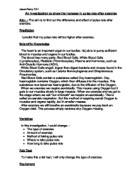The diaphragm's job is to help pump the carbon dioxide out of the lungs and pull the oxygen into the lungs. The diaphragm is a sheet of muscles that lies across the bottom of the chest cavity. As the diaphragm contracts and relaxes, breathing takes place. When the diaphragm contracts, oxygen is pulled into the lungs. When the diaphragm relaxes, carbon dioxide is pumped out of the lungs.
The skeletal system
The skeletal system (206 bones) form a rigid framework to which the softer tissues and organs of the body are attached. Vital organs are protected by the skeletal system. The brain is protected by the surrounding skull as the heart and lungs are encased by the sternum and rib cage. Bones serve as a storage area for minerals such as calcium and phosphorus. When an excess is present in the blood, build up will occur within the bones. When the supply of these minerals within the blood is low, it will be withdrawn from the bones to replenish the supply.
Divisions of the Skeleton
The human skeleton is divided into two distinct parts:
The axial skeleton consists of bones that form the axis of the body and support and protect the organs of the head, neck, and trunk.
-
-
-
-
The appendicle skeleton is composed of bones that anchor the appendages to the axial skeleton
-
-
-
- -(the sacrum and coccyx are considered part of the vertebral column)
Types of bones
The bones of the body fall into four general categories: long bones, short bones, flat bones, and irregular bones. Long bones are longer than they are wide and work as levers. The bones of the upper and lower extremities (ex. humorous, tibia, femur, ulna, metacarpals, etc.) are of this type. Short bones are short, cube-shaped, and found in the wrists and ankles. Flat bones have broad surfaces for protection of organs and attachment of muscles (ex. ribs, cranial bones, bones of shoulder girdle). Irregular bones are all others that do not fall into the previous categories. They have varied shapes, sizes, and surfaces features and include the bones of the vertebrae and a few in the skull.
Bone composition
Bones are composed of tissue that may take one of two forms. Compact, dense bone, spongy, or cancellers bone. Most bones contain both types. Compact bone is dense, hard, and forms the protective exterior portion of all bones. Spongy bone is inside the compact bone and is very porous (full of tiny holes). Spongy bone occurs in most bones. The bone tissue is composed of several types of embedded in a web of inorganic salts (mostly calcium and phosphorus) to give the bone strength, and collagenous fibres and ground substance to give the bone flexibility.
Muscular System
The human body contains more than 650 individual muscles which are attached to the skeleton, which provides the pulling power for us to move around. The main job of the muscular system is to provide movement for the body. The muscular system consists of three different types of muscle tissues: skeletal, cardiac, smooth. Each of these different tissues has the ability to contract, which then allows body movements and functions. There are two types of muscles in the system and they are the involuntary muscles, and the voluntary muscles. The muscle in which we are allow to control by ourselves are called the voluntary muscles and the ones we cam not control are the involuntary muscles. The heart, or the cardiac muscle, is an example of involuntary muscle.
Cardiac muscle
The cardiac muscle is the muscle of the brain itself. The cardiac muscle is the tissue that makes up the wall of the heart called the myocardium. Also like the skeletal muscles, the cardiac muscle is striated and contracts through the sliding filament method. However it is different from other types of muscles because it forms branching fibres. Unlike the skeletal muscles, the cardiac muscle is attached together instead of been attach to a bone
Skeletal muscle
The skeletal muscle makes up about 40 % of an adults body weight. It has stripe-like markings, or striations. The skeletal muscle is composed of long muscle fibres. Each of these muscles fibre is a cell which contains several nuclei. The nervous system controls the contraction of the muscle. Many of the skeletal muscle contractions are automatic. However we still can control the action of the skeletal muscle. And it is because of this reason that the skeletal muscle is also called voluntary muscle
Smooth muscle:
Much of our internal organs are made up of smooth muscles. They are found in the urinary bladder, gallbladder, arteries, and veins. Also the digestive tract is made up of smooth muscle as well. The smooth muscles are controlled by the nervous system and hormones. We cannot consciously control the smooth muscle that is why they are often called involuntary muscles.







